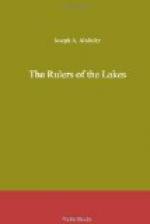He awoke about midnight and sat up on his blanket, looking around at the sleeping forms, dim in the darkness. He distinguished Tayoga near him, just beyond him the mighty figure of Willet, then that of Rogers, scarcely less robust, and farther on some of the white men. He did not see Black Rifle, but he felt sure that he was in the forest, looking for the signs of Indians and hoping to find them. Daganoweda also was invisible and it was likely that the fiery young Mohawk chief was outside the camp on an errand similar to that of Black Rifle. He was able to trace on the outskirts the figures of the sentinels, shadowy and almost unreal in the darkness, but he knew that the warriors of the Ganeagaono watched with eyes that saw everything even in the dusk, and listened with ears that heard everything, whether night or day.
He fell again into a doze or a sort of half sleep in which Tarenyawagon, the sender of dreams, made him see more pictures and see them much faster than he ever saw them awake. The time of dreams did not last more than half an hour, but in that period he lived again many years of his life. He passed once more through many scenes of his early boyhood when Willet was teaching him the ways of the forest. He met Tayoga anew for the first time, together they went to the house of Mynheer Jacobus Huysman in Albany, and together they went to the school of Alexander McLean; then he jumped over a long period and with Willet and Tayoga had his first meeting with St. Luc and Tandakora. He was talking to the Frenchman when he came out of that period of years which was yet less than an hour, and sat up.
All the others save the sentinels were asleep, but his delicate senses warned him that something was moving in the forest. It was at first an instinct rather than anything seen or heard, but soon he traced against the misty background of the dusk the shadowy figures of moving Mohawks. He saw the tall form of Daganoweda, who had come back from the forest, and who must have come because he had something to tell. Then he made out behind the Mohawk chief, Black Rifle, and, although he could not see his features, the white man nevertheless looked swart and menacing, an effect of the day carried over into the night.
It was Robert’s first impulse to lie down again and pretend not to know, but he remembered that he was in the full confidence of them all, a trusted lieutenant, welcomed at any time, anywhere, and so remembering, he arose and walked on light foot to the place where Daganoweda stood talking with the others. The Mohawk chief gave him one favoring glance, telling him he was glad that he had come. Then he returned his attention to a young Indian warrior who stood alert, eager and listening.
“Haace (Panther), where did you find the sign that someone had passed?” he asked.
“Two miles to the north Gao (the wind) brought me a sound,” replied Haace. “It was light. It might have been made by the boughs of Oondote (a tree) rubbing together, but the ears of Haace told him it was not so. I crept through Gabada (the forest) to the place, whence the sound had come, and lo! it and whatever had made it were gone, but I found among the bushes traces to show that moccasins had passed.”




